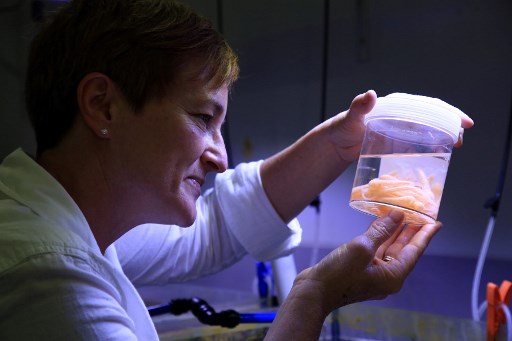

A giant starfish-eating snail could be unleashed to help save the Great Barrier Reef, officials said on September 18, with a trial underway to breed thousands of the rare species. / AFP / Australian Institute of Marine Science /
SYDNEY, Australia (AFP) — A giant starfish-eating snail could be unleashed to help save the Great Barrier Reef, officials said Monday, with a trial underway to breed thousands of the rare species.
Predatory crown-of-thorns starfish, which munch coral, are naturally-occurring but have proliferated due to pollution and run-off at the struggling World Heritage-listed ecosystem.
Their impact has been profound with a major study of the 2,300-kilometer (1,400-mile) long reef’s health in 2012 showing coral cover halved over the past 27 years, with 42 percent of the damage attributed to the pest.
Now Australian Institute of Marine Science (AIMS) research has shown they avoid areas where the Pacific triton sea snail — also known as the giant triton — is present.
The snails — which can grow to half a meter — have a well developed sense of smell and can hunt their prey by scent alone.
Research showed they were particularly fond of crown-of-thorns, but only eat a few each week, and with the snail almost hunted to extinction for their shells, there are not many left.
This led the Australian government to Monday announce funding to research breeding them.
“The possibilities the triton breeding project opens up are exciting,” said Queensland federal MP Warren Entsch.
“If successful, this research will allow scientists to closely look at the impact of giant tritons on crown-of-thorns behavior and test their potential as a management tool to help reduce coral lost to outbreaks.”
Giant tritons held at AIMS have laid numerous egg capsules, with over 100,000 swimming larvae hatching in the last month. But they are so rare, almost nothing is known about their life cycle.
The research will focus on helping the larvae transition to their juvenile and adult stages, providing valuable insights into their biology, with the ultimate aim to deploy them to prevent crown-of-thorns aggregating closely during spawning seasons.
Until now expensive chemicals such as bile salts have been used to try and eradicate the starfish, but they can harm other marine organisms.
In April, research showed they can be safely killed by common household vinegar, but dive teams would need to individually inject each starfish before it dies and breaks-up, making it a massive job.
The Great Barrier Reef, the largest living structure on Earth, is also reeling from an unprecedented second straight year of coral bleaching due to warming sea temperatures linked to climate change.
© Agence France-Presse
